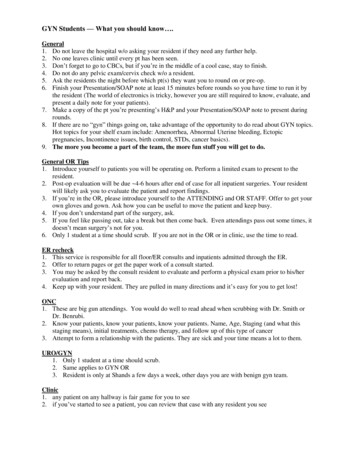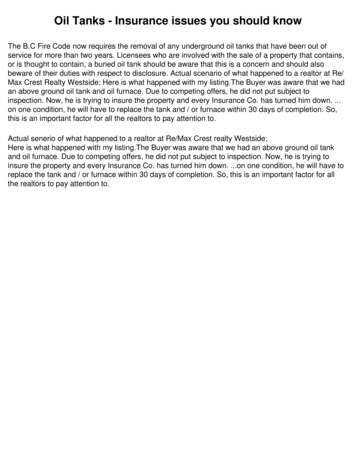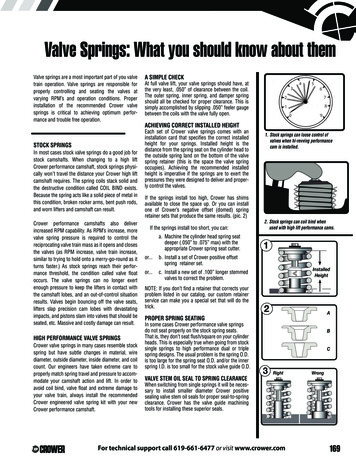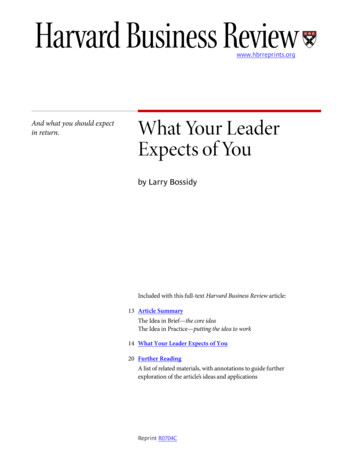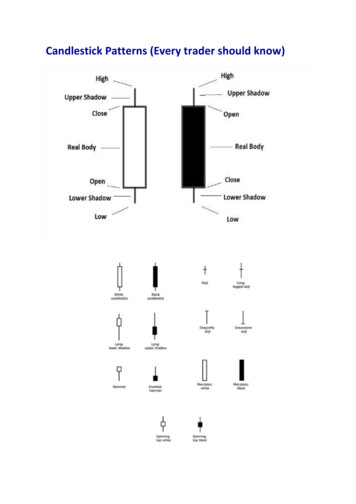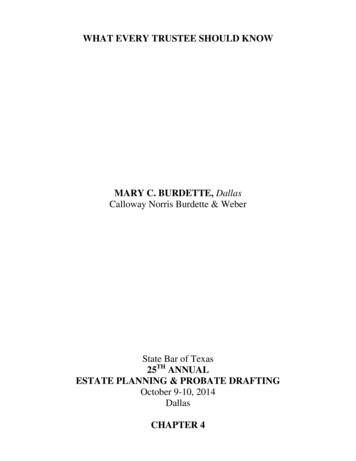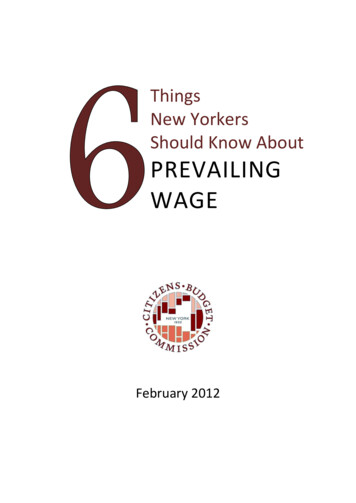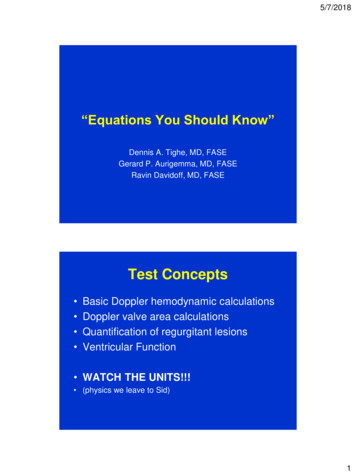
Transcription
5/7/2018“Equations You Should Know”Dennis A. Tighe, MD, FASEGerard P. Aurigemma, MD, FASERavin Davidoff, MD, FASETest Concepts Basic Doppler hemodynamic calculationsDoppler valve area calculationsQuantification of regurgitant lesionsVentricular Function WATCH THE UNITS!!! (physics we leave to Sid)1
5/7/2018Doppler Hemodynamic Calcualtions Volumetric flow–––––Stroke volumeCardiac output/indexRegurgitant volumes and regurgitant fractionsStenotic areasShunt fractionsDoppler Hemodynamic Calculations Basic Equation–Q V x CSA Q volumetric flow (ml/s) V velocity (cm/s) CSA cross sectional area (cm2)– Circular– πR2 π(D/2)2 0.785D22
5/7/2018Doppler Hemodynamic CalculationsIrvine T et al. Heart 2002;88(Suppl IV):iv11. Ask you to calculate either SV or CO– Will be given VTI (cm), LVOT diameter (cm), HRalong with other distracters– SV VTI x CSA– CO SV x HR– CI (SV x HR)/BSAQuestion Evaluation of a patient in the ICU reveals the following:–––––HR 80/minLVOT diameter 2.0 cmLVOT VTI 15 cmMitral VTI 12 cmBP 130/70 mm Hg What is the cardiac output?–––––A.B.C.D.E.3.0 L/min3.3 L/min3.8 L/min4.0 L/min4.5 l/min3
5/7/2018Doppler Hemodynamic Calculations Continuity Principle– Conservation of mass What mass flows in must flow out– Used in calculations of stenotic orifice areasand regurgitant orifice areas and regurgitantvolumes and fractions BASIC EQUATION– Q1 Q2 CSA1 x VTI1 CSA2 x VTI2Continuity PrincipleBaumgartner H et al. J Am Soc Echocardiogr 20094
5/7/2018Question A 70 year-old man is being evaluated for aortic stenosis.The following measurements were obtained.–––––LVOT diameter 2.0 cmAV peak gradient 48 mm HgAortic valve mean gradient 32 mm HgAortic valve VTI 63 cmLVOT VTI 20 cm The AVA is calculated to be which of the following?–––––A.BC.D.E.0.6 cm20.8 cm21.0 cm21.2 cm21.4 cm2Continuity Principle Proximal Isovelocity Surface Area (PISA)– Estimates volumetric flow based on color flowDoppler and spectral Doppler measurements– As flow approaches a restrictive orifice, isovelocityshells of increasing velocity and reducing area(radius) are formed. Used most commonly in calculations ofregurgitant orifice area (EROA), regurgitantvolumes, and regurgitant fractions.– Can be used to calculate stenotic orifice areas5
5/7/2018PISA—Basic EquationQ 2πr2 x VaZoghbi WA et al. J Am Soc Echocardiogr 2003;16:777.VReg6
5/7/2018Bernoulli EquationGenerally can ignore flow accelerationand viscous friction termsModified Bernoulli EquationΔP 4V2If V1 1.5 m/sec it must be included!!ΔP 4 (V22 – V12)Valve Area Calculations—Stenotic Valve Lesions7
5/7/2018Valve Area Calculations Continuity Equation– CSAprox x VTIprox CSAsten x VTIsten– CSAsten (CSAprox x VTIprox)/VTIstenAortic Valve Area AVA (CSALVOT x VTILVOT)/VTIAVx8
5/7/2018Dimensionless Velocity RatioDVR Baumgartner H et al. J Am Soc Echocardiogr 20099
5/7/2018Mitral Valve Area Pressure half-time–MVA 220/PHT Deceleration time– PHT 0.29 x DT– MVA 759/DTQuestionThe best estimate of the mitral orifice area is:t 561 msec A.B.C.D.E.0.40 cm20.75 cm21.0 cm21.4 cm22.6 cm210
5/7/2018Mitral Valve Area Continuity Equation– MVA (CSALVOT x VTILVOT)/VTIMVxMVA Mitral Valve Area—PISABy continuity, boundaryflow equals flow acrossthe stenotic mitral orifice(MVA x Vp)– Thus: 2pR2 x Vn MVA xVp– Rearranging: MVA 2pR2 x Vn / Vp– Due to doming, anglecorrection must be usedMVA (2πR2 x Vn)Vp x (a /180)11
5/7/2018Baumgartner H et al. J Am Soc Echocardiogr 200912
5/7/2018Quantification ofRegurgitant LesionsIrvine T et al. Heart 2002;88(Suppl IV):iv1113
5/7/2018ContinuityIrvine T et al. Heart 2002;88(Suppl IV):iv11Mitral RegurgitationPulsed Doppler Quantitation Stroke volume CSA x VTI– πD2/4 x VTI 0.785 D2 x VTI– Regurgitant volume (RVol) RVol SVRV - SVCV RVol MV inflow - AV outflow(CSAMV x VTIMV) - (CSALVOT x VTILVOT)– Regurgitant fraction (RF)RF (RVol / MV flow) x 100– Effective Regurgitant Orifice Area (ERO)ERO RVol/VTIMR14
5/7/2018Proximal Isovelocity Surface Area(PISA) MethodBy continuity,boundary flow(2pR2 x Va ) equalsflow across theregurgitant orifice(ERO x Vp)VpEROA 2πR2 x Va / Vp15
5/7/2018Let’s Do the Math! EROMR 2πR2 x (VN / VP)– EROMR 6.28 (0.54 x 0.54) x (32/439)– EROMR 0.13 cm2 Simplified method– Set Nyquist limit at 40 cm/s and assume thatMR velocity is 500 cm/s– Then: ERO R2 / 2Summary: MR Severity16
5/7/2018Aortic Regurgitation– Quantitative Doppler Regurgitant volume (RVol)– RVol AV flow - MV flow» AV flow LVOT annulus area x AV VTI» MV flow MV annulus area x MV VTI Regurgitant fraction (RF)– RF (RVol / AV flow) x 100Aortic Regurgitation:Quantification Proximal Isovelocity Surface Area method– Continuity principle– Effective regurgitant orifice (ERO) area EROA flow rate/peak AR velocity EROA ( 2 p R2 x Valias) / Vpeak17
5/7/2018Let’s Do the Math! EROAR 2πR2 x (Valias / Vpeak)– EROAR 6.28 (0.52 x 0.52) x (37/483)– EROAR 0.13 cm2R0.52 cmValiasVpeak483 cm/s18
5/7/2018Summary: AR SeverityVentricular Function19
5/7/201820
5/7/2018Irvine T et al. Heart 2002;88(Suppl IV):iv11How to do PISA-III Measure the peakvelocity of the MR jetas parallel to flow aspossible Trace the spectralprofile to determinethe VTI of the MR jet21
5/7/2018Mitral StenosisRifkin RD et al. J Am Coll Cardiol 1995;26:458.22
Mitral Valve Area Continuity Equation –MVA (CSA LVOT x VTI LVOT)/ VTI MV MVA x Mitral Valve Area—PISA By continuity, boundary flow equals flow across the stenotic mitral orifice (MVA x V p) – Thus: 2pR2x V n MVA x V p – Rearranging: MVA 2pR2x V n / V p – Due to doming, angle correction must be used MVA (2πR2 x Vn .File Size: 1MB
